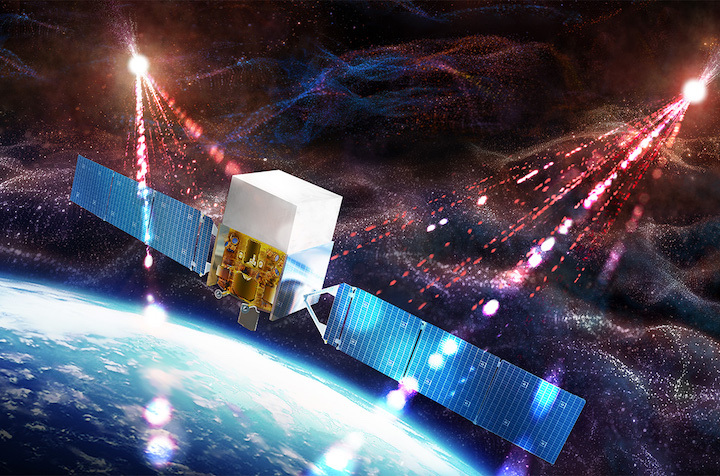9.04.2022
Gamma rays from distant pulsars could help find merging supermassive black holes

Researchers have found a new way to search for gravitational waves, the ripples in spacetime caused by massive celestial objects exploding, whirling, or merging. Physicists first sensed waves in 2015 with laser-based detectors, and other scientists have been chasing them with Earth-based radio telescopes. Now, the hunt has moved to space. A new study reveals that data from the Fermi Gamma-ray Space Telescope can, in theory, also sense a passing wave. Although the technique is not yet accurate enough to make an actual detection, it is already helping other researchers sharpen their analyses.
Discovering that Fermi could do this “was a big surprise for us,” says team leader Matthew Kerr, a gamma ray astronomer at the Naval Research Laboratory. When the telescope was launched nearly 14 years ago, “this was so far off the radar.”
Gravitational waves, predicted by Albert Einstein’s general theory of relativity, happen when immense masses—such as black holes or neutrons, the dense cores of burned out stars—move violently, whirling around and crashing into each other. Since 2015, two large Earth-based detectors, the Laser Interferometer Gravitational-Wave Observatory (LIGO) in the United States and Europe’s Virgo, have detected dozens of black hole mergers and a single pair of neutron stars. The detectors fire lasers through kilometers-long vacuum tubes. When a wave passes, it alters the length of the tube by as little as 1/10,000th of the width of a proton, which the lasers then detect.
Radio astronomers are after bigger prey than LIGO and Virgo: They’re looking for megamergers, the union of supermassive black holes that each weigh billions of Suns. Such black holes lurk at the centers of galaxies; when two galaxies merge, it is thought that the black holes closely orbit each other and slowly come together. Conventional telescopes are never going to pick out such a pair in a distant galaxy, says gravitational wave theorist Chiara Mingarelli of the University of Connecticut, Storrs. Gravitational waves “may be the only evidence we’ll ever see.”
Because the waves produced by such a spiraling duo are long—one cycle takes years to pass—catching them requires a galaxywide net. Instead of using lasers and vacuum tubes, radio astronomers turn to pulsars, neutron stars that spew radiation from their poles. As they spin, that radiation sweeps across the sky like a supercharged lighthouse beam. On Earth, astronomers see flashes hundreds of times a second from some pulsars, arriving as regularly as the ticks of an atomic clock. A passing gravitational wave will slightly alter the distance between a pulsar and Earth, so by monitoring the arrival times of pulses from a collection of pulsars across the Milky Way over many years—known as a pulsar timing array (PTA)—astronomers hope to detect slight variations which signal passing gravitational waves.
Last year, using data gathered over more than a dozen years, PTA teams in North America and Europe announced they had picked up faint statistical signals suggestive of something known as the gravitational wave background, a reverberation of all the supermassive black hole mergers across a large swath of the universe. Analyzing a few more years of data, which the teams are doing now, may solidify those claims.
And now Fermi has entered the fray. Pulsars emit gamma rays, in addition to their flood of radio waves. But many astronomers doubted their instruments would sense enough to detect gravitational waves. Kerr and colleagues decided to find out. They searched through 12.5 years of Fermi’s archive for gamma ray photons from about 30 suitable pulsars. Unlike the radio PTAs, which must target specific pulsars for brief windows of time, Fermi constantly watches a large swath of the sky, so several pulsars are almost always in view. But photons in the gamma range are so rare, “Fermi can look all week and see no photons,” Kerr says.
Still, the team reports today in Science, their trawl through the Fermi archive turned up enough photons to make a gamma ray PTA. Like their radio colleagues, Kerr and his team were not able to definitively detect the gravitational wave background. But they were able to set an upper limit to the value of their signal. Kerr concedes that the gamma-based limit is only about one-third as tight as those from radio PTAs, but it will improve as Fermi collects more data. “So, if Fermi doesn’t fall out of the sky, we will have comparable sensitivity” in 5 to 10 years, he says.
“This is a really interesting paper,” says Maura McLaughlin of West Virginia University, a leader of NANOGrav, one of the radio PTA teams. Although the gamma ray effort is still playing catchup, it can already contribute. “One very useful thing the gamma ray data can do is help us understand the effect of the interstellar medium,” which is a major source of noise in PTA searches, McLaughlin says. This wisp of particles and radiation can bend the path of radio waves and slow some frequencies more than others, smearing out the signal. But gamma rays get a free pass, and by comparing pulsar signals from radio and gamma rays, researchers can better understand the interstellar noise, and potentially identify the fingerprint of gravitational waves. Gamma ray signals are “an independent measure,” says Mingarelli, also a member of the NANOGrav team. “It adds to our gravitational wave detection toolkit.”
Once the PTAs—radio and gamma ray—have identified the gravitational wave background, the next target will be individual supermassive black hole binaries to find out how these swirling behemoths affect the galaxies around them. “It’s a whole new way of observing the universe,” Mingarelli says. “Who knows what we’ll find?”
Quelle: AAAS

